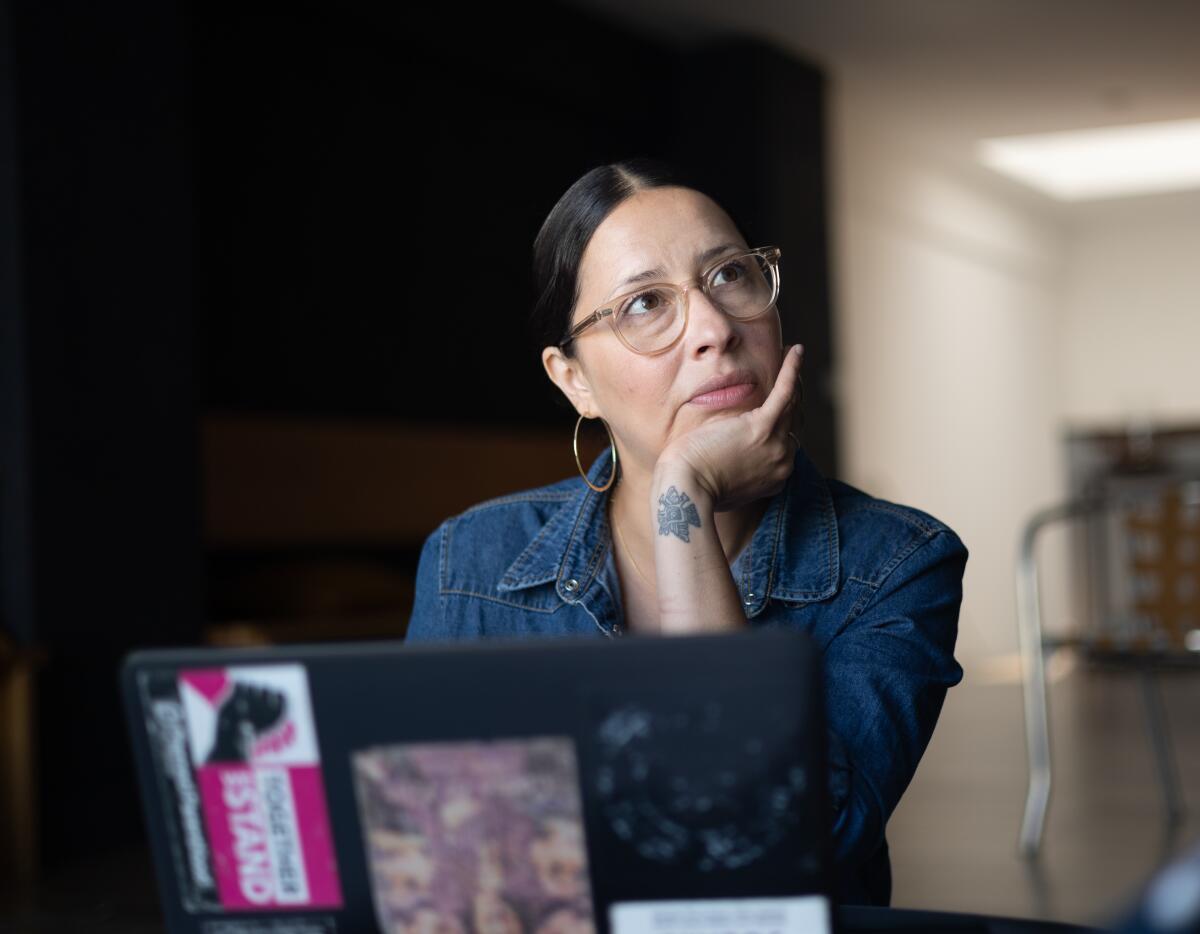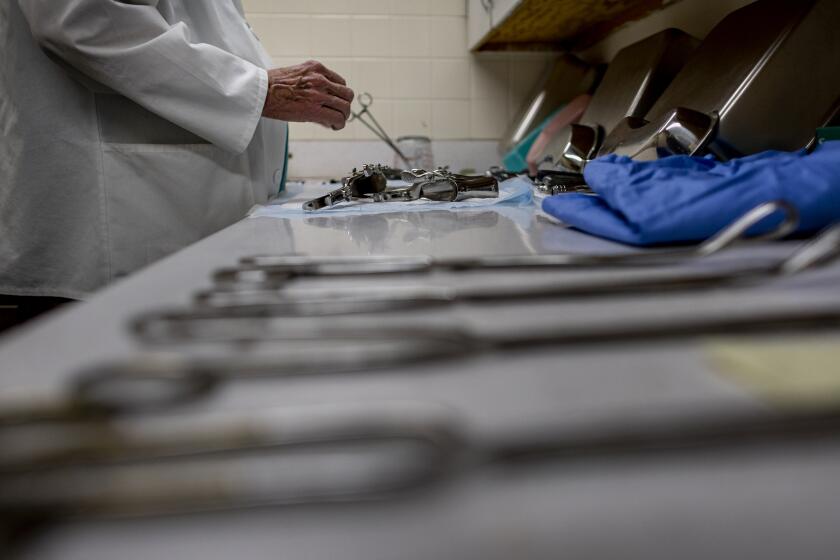These California nurse-midwives want to provide abortions. They’re struggling to get trained

When Ariela Schnyer was choosing where to get trained as a nurse-midwife, California stood out for an important reason: The state would allow clinicians like her to provide abortions.
But three years later, after graduating from her nurse-midwifery program at UC San Francisco, Schnyer is not yet prepared to provide abortions that require hands-on care. After the news broke that Roe vs. Wade had been overturned — a shift that is expected to send more abortion patients to California — Schnyer was trying to find out whether she could get trained in Mexico City.
“It feels frustrating to have that theoretical training,” she said, “but not be able to jump into the gaps that are going to be here.”
As Texas, Mississippi and other states have clamped down on abortion, California leaders have vowed to make their state a haven for abortion patients. UCLA researchers have estimated that 8,000 to 16,000 more patients will head to California annually for abortions after the Supreme Court ruling.
But the limited availability of abortion training has constrained the number of clinicians who can provide the procedure, abortion rights advocates warn.
California lawmakers have laid the legal groundwork for a range of health providers to provide abortions, but certified nurse-midwives and other eligible health professionals say that scant opportunities for training have made it harder for them to do so. The obstacles to getting trained are steeper for abortions that involve a physical procedure than for medication abortions, which use pills to end a pregnancy.
The Biden administration is telling hospitals that they “must” provide abortion services if the life of the pregnant woman is at risk
When California changed its laws to allow more health professionals to provide early abortions, “many people came to California to become clinicians, thinking that they would be able to be abortion providers — and then there was no training available to them,” said Debbie Bamberger, a nurse practitioner and board member of Training in Early Abortion for Comprehensive Healthcare, a group focused on abortion training.
Obstetrician gynecologists are supposed to get access to abortion training in their medical residencies under accreditation requirements, although residents can choose to opt out. Other physicians can also become trained in abortion care, but such opportunities have been sparser.
Abortion access advocates estimate that in California, roughly a fifth of family medicine programs routinely offer “opt-out” abortion training under their residency programs; nationally, the estimated number is under 6%.
For physicians, if it isn’t covered in medical school, “you’re most likely going to enter residency with very little to no education in abortion,” said Flor Hunt, executive director of TEACH. “And then if your residency program doesn’t have a meaningful abortion rotation, your chances of then being able to get abortion training are very low.”
Then there are other health professionals including certified nurse-midwives: nurses who complete additional higher education in pregnancy and childbirth. California allows nurse practitioners, physician assistants and certified nurse-midwives to provide abortions using suction early in pregnancy — also known as aspiration abortions — if they get training and follow other requirements under a law passed in 2013.
But that training can also be hard to get. Kim Q. Dau, who directs a UC San Francisco nurse-midwifery education program, said that when that law passed, the program was quick to provide training through lectures and reading but has “struggled over many years to find the hands-on learning experience.”
Many of the local sites that can train her students are already teaching physicians, which limits their capacity to bring in more trainees. “To teach anything takes more time and energy” than simply doing it without training anyone at the same time, Dau said, and clinics are concerned about not being able to see as many patients as a result.
Schnyer, who recently graduated from the midwifery program, said she had gotten training on medication abortions and had a chance to practice with tools used in early abortions on a papaya. But she had limited chances to observe procedural abortions. Her midwifery program gave her an opportunity to assist with preparing patients for abortions, but not the actual procedure, she said.
“It is kind of frustrating to leave school without that skill under my belt, in terms of actual clinical training,” Schnyer said.
She hopes to find a job that will assist her in getting trained. In the meantime, Schnyer is looking into whether she might be able to continue her training at a Mexico City clinic.

Zoe Carrasco, another graduate from the UC San Francisco midwifery program, also said she had limited opportunities for hands-on training in abortion, which meant that “we only saw a small glimpse of what abortion management looks like.”
Carrasco had wanted to help provide access to abortion care as a Latina provider who speaks Spanish, but doesn’t feel prepared to do so with the amount of training she has received. Like Schnyer, she is hoping she might be able to get trained on the job, but knows that those opportunities are also rare.
That scarcity, she said, “is a reflection of how abortion is viewed in this country.”
The California law that paved the way for physician assistants, nurse-midwives and nurse practitioners to provide aspiration abortions does not mandate a specific number of hours of training, but says the required training must be recognized by state boards or, for physician assistants, other options outlined in state code.
In an analysis of training opportunities across the country, the reproductive rights advocacy and educational group Nurses for Sexual and Reproductive Health found that most abortion training is focused on medical doctors; it identified only one program across the country offering “clinical training” — hands-on education meant to build clinical skill — in abortion care for registered nurses. Two others accepted “advanced practice clinicians” such as nurse practitioners.
Nurse-midwifery programs are focused on preparing students to take a licensing exam, and unless abortion procedures are on that test, “it’s hard to get programs to really robustly incorporate that into education,” said Anna Brown, a registered nurse and director of education for Nurses for Sexual and Reproductive Health.
Tiffany Lundeen, a certified nurse-midwife who works in Contra Costa County, said that during her graduate school training at Yale University, “there were no opportunities for me to be trained in abortion care.” After she graduated, Lundeen went to work in federally qualified health centers — community clinics that provide primary care to poor and uninsured patients.
Lundeen sees abortion as something that should be part of primary care — “as fundamental to health and well-being as getting your screening tests for cancer.”
But because such clinics rely heavily on federal funding, they often steer clear of providing abortion care, Lundeen said.
“What that means is I don’t have access to on-the-job training in abortion care,” Lundeen said. “I could never find another way to be trained.” Lundeen said she tried reaching out to nonprofits trying to fill that gap, but found that they had limited capacity.
Abortion training has been limited, in part, by the number and distribution of existing providers in California. Bamberger estimated that to become adept in procedural abortions takes being trained with an abortion provider on 20 to 50 procedures. Broad swaths of the state have no abortion providers at all.
“In order to provide training, we have to be able to do the abortions in the first place,” said Dr. Melissa Myo, a complex family planning fellow at L.A. County-USC Medical Center. “Even in places like California where it is legal, access is an issue” because many rural counties lack an abortion provider.
At Planned Parenthood Mar Monte, which covers dozens of health centers from Sutter County to Bakersfield, nurse practitioners and midwives can get hands-on training, but “it’s just one person at a time,” Bamberger said. Clinicians can get trained quicker in providing medication abortion but need added training to step in if complications occur, Bamberger said.
“There’s a vicious cycle with not enough providers and not enough training — which produces not enough providers,” said Ian Lague, curriculum and program manager with Reproductive Health Education in Family Medicine, a group seeking to integrate abortion training into residency programs for family physicians.
For that reason, the group has emphasized training in medication abortion, which is simpler to learn. “There is a deluge of people who want to help in this moment, and while it would be wonderful to get them trained in procedural abortion, this is the low-hanging fruit.”
“The Future of Abortion” is a series of stories about the state of abortion is it is challenged in America.
Dr. Katrina Heyrana, a fellow in family planning at County-USC, said it has been refreshing to see doctors from all specialties being galvanized by the Supreme Court ruling. Physicians have asked her, “How can I become a mifepristone prescriber?” — one of the medications used to end a pregnancy.
California lawmakers are also trying to help: Under Assembly Bill 1918, one in a package of state bills aiming to expand and protect abortion access, the state would create the California Reproductive Health Service Corps to recruit a diverse workforce by offering scholarships, stipends and loan repayment for health professionals who get abortion training and agree to work three years in underserved areas of the state.
The recently enacted state budget includes $20 million for the health service corps and an additional $20 million for scholarships and loan repayment to healthcare providers who commit to providing reproductive healthcare services.
Health educators are also anticipating that more out-of-state physicians will come to California for training as abortion is criminalized in other states. Two years ago, 92% of OB-GYN residents reported that they had some access to abortion training; UCLA and UC San Francisco researchers estimated that number would fall to 56% — and possibly lower — after Roe was overturned.
Training out-of-state doctors is important, but “I definitely think there’s going to be a bottleneck,” said Heyrana, who will soon start a new job training medical residents in abortion care. “We need to train our residents to feel comfortable in providing this care — and now have the added burden of having to train residents in probably over half the country.”
Times staff writer Melody Gutierrez contributed to this report.
More to Read
Sign up for Essential California
The most important California stories and recommendations in your inbox every morning.
You may occasionally receive promotional content from the Los Angeles Times.












